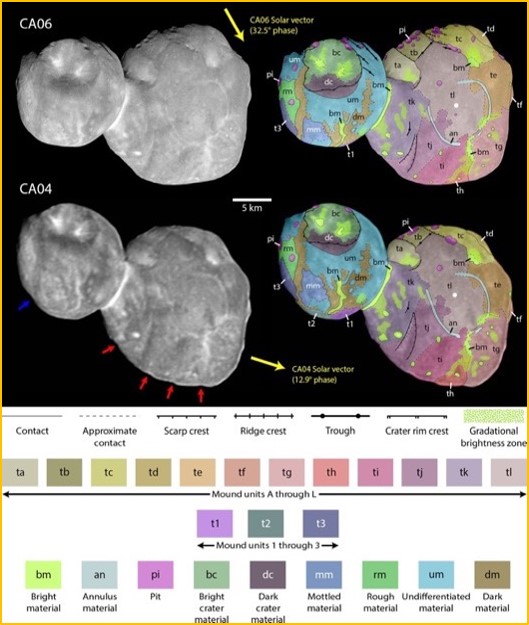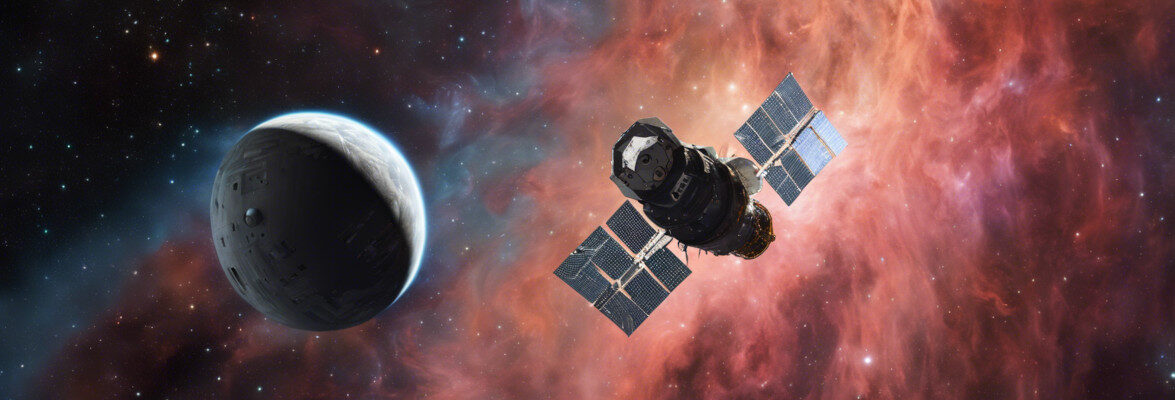
An article published in the journal “The Planetary Science Journal” reports a study on the mound-like formations found on asteroid Arrokoth by NASA’s New Horizons space probe. The images collected show that especially the largest lobe, which was named Wenu, is dominated by these geological features but the smaller lobe, which was named Weeyo, has some of them as well. A team of researchers led by Alan Stern conducted simulations that indicate that these are the traces of smaller bodies that coalesced in the very early history of the solar system. This offers new insights into the formation mechanisms not only of asteroids but also of larger rocky bodies.
The top image (Courtesy Southwest Research Institute (SwRI)) shows a mosaic of photos of Arrokoth taken by the New Horizons space probe’s LORRI instrument on the left and a geologic map of the asteroid on the right.
The 2019 New Year’s Arrokoth flyby was a very interesting event for astronomers. It offered the opportunity to closely observe what is considered a fossil dating back to the initial phase of the history of the solar system. At the time, it was still known by the nickname Ultima Thule.
The considerable distance of the New Horizons space probe made the transmission of images and data detected with various on-board instruments very slow but now researchers interested in studying the formation of rocky bodies have a lot of information for their geological analyses.
Among the geological features found on Arrokoth, the mounds that especially mark the great Wenu lobe are among the most striking. Despite this, at least in the initial stages of studies following the 2019 New Year flyby, they received limited attention. Now Alan Stern’s team at the Southwest Research Institute (SwRI) conducted a specific study that offers interesting conclusions.
Alan Stern’s team identified 12 mounds on Arrokoth’s Wenu lobe that have very similar shapes, sizes, colors, and reflectivity. Another 3 mounds with features that may be of the same type were tentatively identified on the Weeyo lobe. Simulations indicate that Arrokoth formed via the so-called streaming instability mechanism, which has been under discussion in recent years. This is a mechanism proposed for the formation of planetesimals in which collisions occur at very low speeds which determines the coalescing of small objects to form larger bodies.
The bottom image (Courtesy New Horizons/NASA/JHUAPL/SwRI/James Tuttle Keane) shows a simulation of Arrokoth’s formation through various stages. Small rotating icy bodies begin to coalesce to form the two lobes of Arrokoth which later merge into the asteroid we know today.
Alan Stern commented that if the mounds are indeed representative of the building blocks of ancient planetesimals such as Arrokoth, models of planetesimal formation will have to explain the preferred size for these building blocks. In short, this study suggests some answers regarding the formation of rock bodies but raises other questions. Stern added that it will be important to search for similar features in other planetesimals by missions such as Lucy, aimed precisely at research on asteroids, for which some flybys are planned.
At least for the moment, no other flybys of Kuiper Belt Objects are scheduled for the New Horizons space probe. However, if one was identified that could be reached with the available fuel, a new mission could begin. These asteroids that remained almost unchanged for a few billion years are very useful to understand the mechanisms that led to the formation of planets as well.


